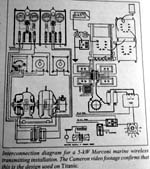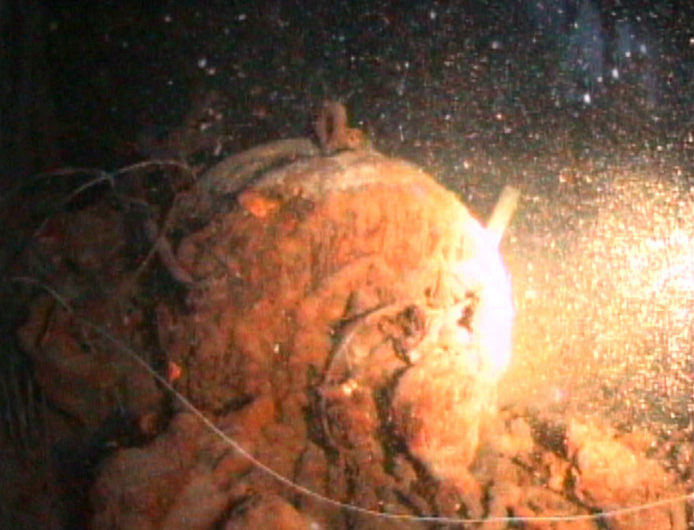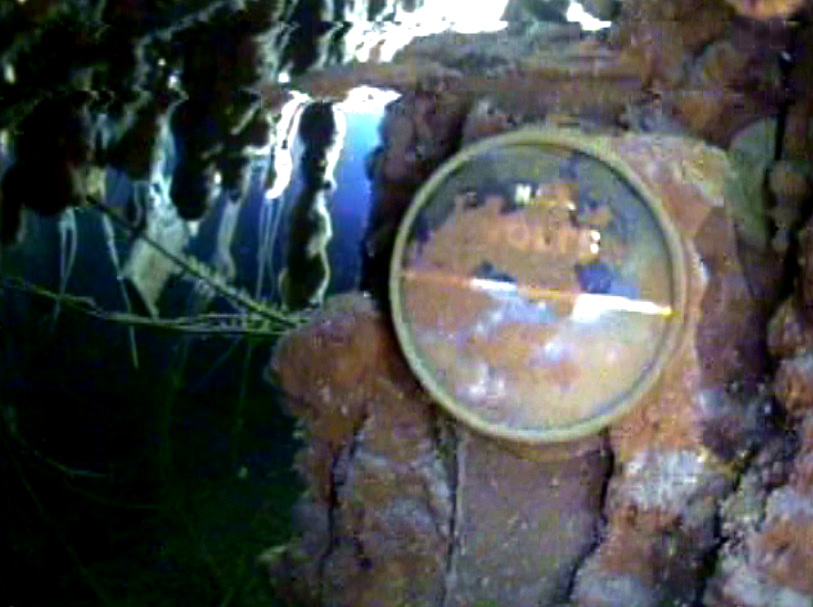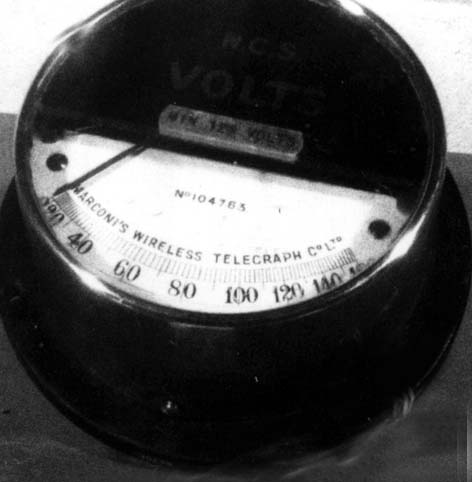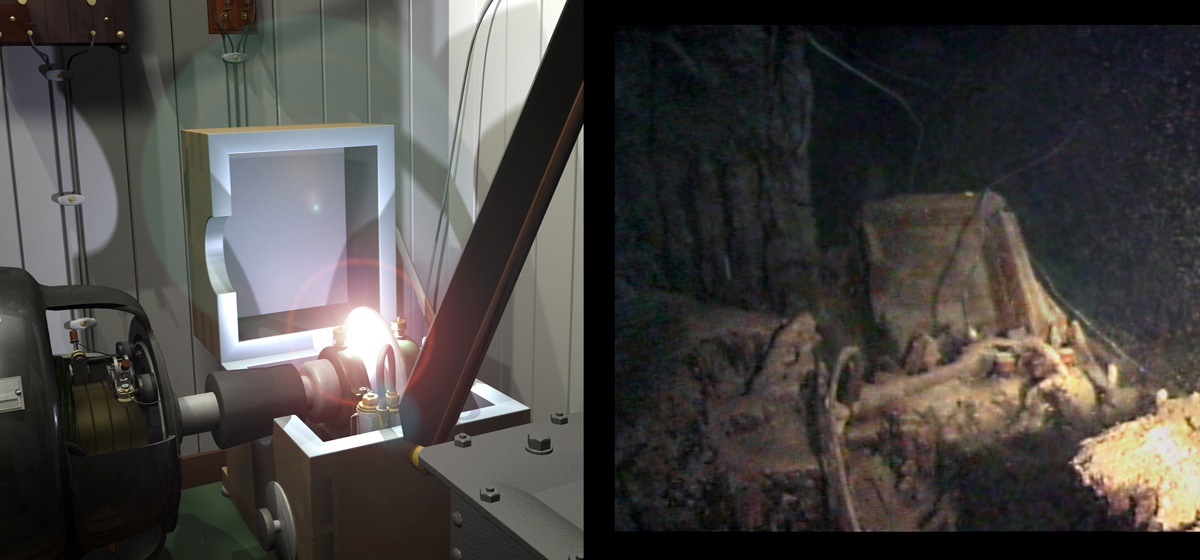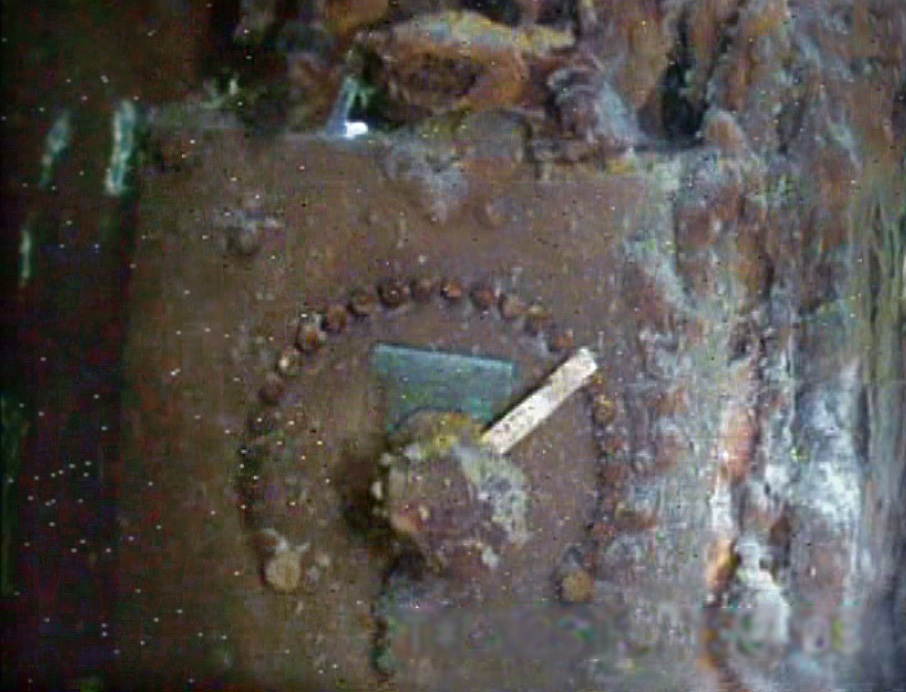FOLLOW ON TO THE STORY....
The Discovery Channel produced a documentary, titled "Last Mysteries
of the Titanic." and in doing so, it captured some ROV footage from inside
the Marconi Room. It was examined in both 2001 and 2005. Here is the analysis
report from the technical advisor (Parks Stephenson):
"The Marconi Room itself, along with the adjacent operators' sleeping
quarters, was completely destroyed during the sinking. There is nothing
but an open area left. The room's original boundaries can be determined
by the pattern of paint remaining in the overhead and dangling electrical
wires which once led to light switches and a heater control switch mounted
on the walls. An electrical distribution panel for the ship's lighting
system that was once embedded in the forward wall of the Marconi cabin
now hangs down by its wires, with a couple of fuses showing evidence of
having blown.
The skylight over the operator's desk is gone, leaving an open hole
in the overhead. The only piece of equipment that could be found
in the room was the accumulator charging switchboard, which lies face down
on top of the sediment that covers the deck, still connected by wires.
Everything else in the room was evidently carried away by the water, presumably
aft into the large open space that housed the Grand Staircase.
The adjacent Silence Cabin, though, survived the sinking, thanks to
the extra thickness of its walls to accommodate sound-proofing. The
transmitting apparatus survived largely intact and is now completely accessible,
thanks to the organisms that have eaten away the walls of the room.
When the room was last seen in 2005, the AC/DC switchboard and field regulators
remained mounted on a fragment of wall. The glass on the AMPERES
and VOLTS dials were still intact on three of the four gauges, the lettering
still visible. The knife switch on the AC side of the board is still
closed, but the knife switch on the DC side is open, indicating that operator
Phillips deliberately shut down the station before departing. The
regulators show the last settings of resistance used to sharpen the spark
as ship's power became increasingly unstable.
The switchboards hang on the wall above the motor-generator set.
The top of the teak box housing the rotary spark generator is locked in
the open position, indicating that operator Bride must have been
listening to the spark as he adjusted the regulators. The condensers
and transformer sit unaffected by the tragedy. The jigger was mounted
on the wall above the condensers and with the wall behind it eaten away,
is held upright only by the copper bands connected to it. The wood
of the jigger box has been largely eaten away and it will soon fall to
pieces. The brass earth arrester for the aerial and tuning lamp,
once mounted on the wall next to the jigger, are still held upright by
connecting wires. The HF spiral inductance coil has also fallen from the
wall to lay atop the bank of condensers. The two choking coil boxes
lie atop the transformer, having also fallen from the wall. The bank
of emergency accumulators sit next to the transformer There is a pile of
debris that accumulated aft and to port (outboard) of the Marconi rooms
in the remains of a passenger stateroom. It is possible that some
of the Marconi radio items were captured in this debris pile, instead of
being pushed aft into the Grand Staircase void".
Spud Roscoe VE1BC and Parks Stephenson add some other background information
to Titanic radio story:
1. CQD and SOS were both authorized distress signals at the time of
the Titanic's maiden voyage.
The 1906 International Radiotelegraph Convention in Berlin established
the 600-metre (long wave) and 300-metre (short wave) as the two wave lengths
authorized for general public service. The normal wave for shipboard use
was established at that time as the 300-metre wave. Call-ups were
made on the normal wave, then the conversation could then be moved to another
wave, provided that was it was under 600 metres or over 1600 metres. The
1912 International Radiotelegraph Convention in London reaffirmed these
two waves and designated the 600- meter wave as the normal wave length
for ships to use. Distress calls were to be made on the normal wave
(600 metres, or 500 kHz). The 1906 Convention was the first to establish
common frequencies.
2. The M prefix was applied to all Marconi call signs on January 1st,
1908, however the "M" prefix was usually not transmitted between Marconi
stations as a shorthand between familiar operators. If broadcasting
in the blind, or talking with another ship that was not Marconi equipped
(like a German Telefunken boat), then the entire call sign was used. This
is before 1912.
After the 1912 Convention, the call letters were more standardized and
the first letter denoted country, rather than company (although, with Marconi
based in England, Great Britain was assigned "M" as one of its first call
letters).
3. The four letter signal flags assigned each ship and the radio call
sign did not become one and the same until January 1st, 1934.
4. The British did not use "de" as the separation signal. They used
the letter V and at least the Navy used it until after World War II.
5. As a rule, all ships were to use the coast station nearest their
position.. But Regulation XXXV, paragraph 2, of the Convention Service
Regulations allows for more distant coast stations to be used under certain
circumstances. In that instance, a wave length of 1800 metres was
to be used.
6. By 1912, though, most ships and coastal stations were working
the 600-metre wave. In the July 1911 issue of the Marconigraph,, the installation
aboard Olympic (Titanic's sister ship) was "arranged to tune in transmissions
to waves of 300 and 600 metres...". Harold Bride also described both 600-
and 300-metre waves in his testimony. According to the Marconi maintenance
manual for the 5-kW apparatus, the adjustment of the closed oscillating
circuit for the production of the long (600-metre) wave was to place the
banks of the main condenser in parallel; for the short (300-metre) wave,
in series. Inside the Titanic wreck, it was observed that the
Swiss commutator was in the parallel position, which means that Titanic
was using the 600-metre wave when she sank.
7. Cyril F. Evans, the wireless operator in CALIFORNIAN with call sign
MWL, did not transmit an ice message to TITANIC. Cyril Evans simply transmitted
CQ V WL and then stated they were stopped in ice for the night in the position
Captain Lord had given him. This message was for all ships in the area
and not just the TITANIC. Jack Philips in TITANIC received this so loud
he simply chastised Evans for interrupting him while trying to transmit
a multitude of messages from his passengers to the Cape Race station with
wireless call sign CE.
Cyril Evans did not properly prefix his message by adding the code "MSG"
in the preamble. According to Evans, he used an informal call up,
"SOM" (Say, old man), then his message. Harold Bride later related
in court that Jack Phillips responded to Evans's informal interruption
with a curt "D-D-D", the silent signal at the time. If Evans had
used the "MSG" prefix, then Phillips would have paused with Cape Race and
taken the message for acknowledgment.
A NEW DEVELOPMENT as of February 21/20
A COMPANY WITH RIGHTS TO REMOVE ARTIFACTS FROM TITANIC ASKS COURT
TO ALLOW IT TO RECOVER FAMOUS RADIO.
By Sheena Jones, CNN
RMS Titanic Inc., a company that has exclusive rights to salvage artifacts
from the Titanic, wants to retrieve the radio used to call for help after
the ship hit an iceberg, according to documents filed in a Virginia federal
court.
A hearing to discuss this matter is scheduled for Thursday, according
to court documents. The removal of the Marconi radio would require the
company to remove a part of the historic ship's deckhouse to access the
"silent room," an area with soundproof walls that housed the wireless radio.
The ship, which was deemed unsinkable before its April 1912 voyage, and
its contents are now protected under the R.M.S. Titanic International Agreement
between the United States and the United Kingdom.
RMS Titanic Inc. would need to obtain federal court approval to work
inside the hull of the ship and remove the rust-covered radio, officials
say. The National Oceanic and Atmospheric Administration says in court
documents that RMS Titanic Inc. has recovered at least 5,000 artifacts
from the ship debris field and that the government wants to protect the
best interest of the public and the Titanic before the company can take
additional artifacts. The agency said intrusive recover activity must be
evaluated based on whether there is a justified educational, scientific
or cultural interests.
The company says its work includes educating the public through expeditions
and artifacts.
Update from the court: In mid May 2020,, a US federal judge in
Virginia has given permission to retrieve the ill-fated RMS Titanic's Marconi
wireless gear, which transmitted distress calls from the sinking ocean
liner during its maiden voyage. Judge Rebecca Beach Smith of the US District
Court in Norfolk ruled that the radio gear is historically and culturally
important and could soon be lost within the rapidly decaying wreck. "The
Marconi device has significant historical, educational, scientific, and
cultural value as the device used to make distress calls while the Titanic
was sinking," Judge Smith wrote in her ruling. She said the company would
be permitted "minimally to cut into the wreck" to access the radio room
WHY DOES RMS TITANIC WANT TO GET THE RADIO NOW?
RMS Titanic Inc. argued in a court document filed last year that
little was known about the most famous radio in history and that the company
wanted to recover it before conditions deteriorated further and the piece
of history was lost. RMS Titanic Inc. cited a report conducted by Titanic
expert Parks Stephenson, who visited the wreck in 2005 and 2010, saying
that large sections of the roof of the deckhouse have collapsed since
2005 . The famous ship, resting about 12,000 feet down in the North Atlantic
Ocean, houses the transmitter in what was known as the Marconi Suite. The
suite, made of steel, consisted of three areas: sleeping accommodations,
an operator's room and the silent room that housed the radio. Each area
was separated by wood walls that officials believe have now dissolved,
the documents say.
THE FINAL CALL MADE FROM THE MARCONI SET
According to the Senate report released on the Titanic, the final calls
from the Marconi began around 10:25 p.m. ET on April 14, 1912. The call
from the operator was a distress signal, or CQD.
The report said the Titanic had been struck by an iceberg. A half hour
later, another message said the vessel was sinking by the head and women
and children were being placed into into lifeboats; the operator noted
the weather was calm and clear.The final message that was audible said,
"Engine room getting flooded." The signals were blurred and ended abruptly.
.Although more than 1,500 passengers and crew perished in the disaster,
the distress calls brought ships that rescued about 700 people.
CNN's Isabelle Lee contributed to this report.
A COMPELLING REASON FOR THE RADIO SET SALVAGE
There are pro and con sides as to the salvage of the radio equipment
from Titanic's Silent Room. The con side says not to salvage the
radio gear because Titanic is a marine grave and should be left alone.
There have been some 5,000 artifacts salvaged so far. On the pro
side, the roof of Titanic's Officer's Quarters Deckhouse in
danger of collapsing and crushing the Silent Room . The equipment should
be removed so its configuration can be studied, otherwise it will be lost
forever.
Parks Stephenson is a volunteer researcher of shipwrecks. He offers
some background information for diving down to the Titanic again,
"Jim Cameron surveyed the remains of the Marconi transmitting room (Silent
Cabin) in 2001 and 2005. The operator's room, with all the receiving
components, was destroyed during the sinking by the flow of water through
the deckhouse. But the Silent Cabin had soundproofed walls, which
withstood the rush of water and protected the transmitting apparatus within.
Over the next century, the organisms that feed off the wreck ate away the
wooden walls, revealing a beautifully complete and intact transmitting
apparatus, the only surviving example of a Marconi 5-kW marine station
in the world. It also happens to make up part of what is arguably
the most famous radio (telegraph, actually, but that’s how the public sees
it) in the world. I am the one who performed the analysis of Jim's
dive imagery and reconstructed what was a unique station. Not even
the Marconi Co. archives had any source material about Titanic’s installation,
given that they were always put together by the local Marconi engineer
to fit the space allocated aboard each vessel.
The components were standard Marconi, it was the manner in which they
were installed that was unique. Each marine station was put together by
a supervising Marconi engineer, tailored to each ship. Olympic was Titanic’s
sister ship and as such was almost identical, but her Marconi Room was
in a different location than Titanic’s. Also, Olympic had a plain spark
discharger, while Titanic (launched a year after Olympic) received the
newer disc discharger. Jim Cameron modeled his movie version of the Marconi
Room on Olympic because it was better documented in photographs. No photograph
of Titanic’s Silent Cabin exists. The Marconi archives had nothing regarding
Titanic, specifically. It wasn’t until after the movie, after Cameron explored
the wreck and found the remains of the Silent Room, that we finally discovered
how different Titanic was from Olympic. Each component, though, is standard
Marconi products and I used their catalogue to help re-create the system
in CGI.
The transmitting apparatus has survived. The wood boxes that house
the jigger, coils and ATI have certainly degraded, but the motor-generator
set (which includes the first rotary discharger to go to sea) looks to
be in good, maybe even restorable, condition. The switchboards and regulators,
still mounted on the steel bars that handled their weight, still show the
last operator settings of motor and alternator. The condenser bank
and transformer are in galvanized steel tubs. Wall mounted components
still hang in space, held up by their connecting wires after the walls
themselves were consumed.
This apparatus needs to be saved, as the deckhouse that has protected
it until now is collapsing. I have noted the ongoing collapse of
the roof of that deckhouse even saw it in person during my dive to the
wreck last year (2019). It won't be long before the remains of the
roof collapses on top of the apparatus, just like it did over Captain’s
Smith bathtub (which we noted for the first time last year).
The wreck doesn't belong to us or this time. We are lucky to still
have the wreck in exploitable condition now. Future generations won't have
that luxury that we take for granted. They will want to connect to
Titanic and any artifacts we rescue from the disintegrating wreck now will
be their link to the ship and its story. I would think as radio men,
you would want this piece of communications history preserved forever"
ABOUT PARKS STEPHENSON
A 1979 graduate of the U.S. Naval Academy, Parks has qualified as both
a submariner and naval flight officer. After retiring from the Navy, Commander
Stephenson joined the defence contracting industry -- first with Hughes
Aircraft, then Raytheon, then Lockheed Martin -- building combat systems
for naval ships and, more recently, integrated command-and-control systems
for national defence.
Parks was employed in 2001 by filmmaker James Cameron as a technical
advisor for his documentary, "Ghosts of the Abyss." Parks also contributed
text and computer-generated 3D models to the film's companion book. Cameron
brought him back in 2005 for the Discovery Channel/Earthship Productions-sponsored
Last Mysteries of the Titanic expedition, where Parks fine-tuned the use
of CG models as forensic tools in the continuing exploration of the wreck's
interior. He's also been a technical/historical advisor for both the History
Channel and National Geographic Channel. Parks dove to the Titanic wreck
in 2005, participated as part of the Lone Wolf Documentary Group expedition
crew during the 2006 and 2009 expeditions to the Britannic wreck, and was
field producer for History during the 2010 RMST/WHOI Titanic Expedition.
Lone Wolf featured Parks as the lead investigator in the 2009 PBS/NOVA
documentary, "Killer Subs in Pearl Harbor," where he led the U.S.-Japanese
team that found and identified the final Japanese midget submarine that
participated in the Pearl Harbor attack.
Parks has a special interest in historical research and forensic re-construction,
specializing in military and maritime areas where he can apply his personal
experience. In addition to a Bachelor of Science degree in Naval Science
from the U.S. Naval Academy, Parks holds a Masters in Political Science
degree from Auburn University.
| CQD de MGY: This link provides a simulation
of the CQD distress call sent by Titanic.. The telegraphist is unknown.
Jack Phillips, the wireless s operator the night the Titanic sank was
a hero who stayed at his post until the very end,. |
FOOTNOTES:
[1] Titanic's visual call sign was HVMP. This information is taken from
the "General Register and Record Office of Shipping and Seamen", 1912.
EQUIPMENT
| TITANIC's RADIO EQUIPMENT
- CALL SIGN MGY |
|
|
| Receiving Equipment |
Main receiver: Marconi MultiTuner. Tunes 2600 to 100m (115 kHz
to 3 MHz), Marconi Magnetic Detector using a Fleming valve
detector with standard telephones (headphones).
Auxiliary receiver: Coherer with Inker/printer. The set did not have
any tuning control |
| Transmuting Equipment |
Main Tx : 5 kW disk discharger set. Input was 100-110 VDC @60
amps Operating frequency: 600 m “longwave” and 325m “shortwave”.
This set produces a CW note of 840 Hz. Range: Day: 250 mi; Night:
2000+ mi, but not guaranteed).
Auxiliary Tx: 1.5 kW plain spark set using 10” coil. Powered by
batteries. Daytime range of approximately 40 mi |
| Antenna |
Twin 'T; balanced type. 450 feet long. Two pairs of wires , two
feed lines to radio. |



